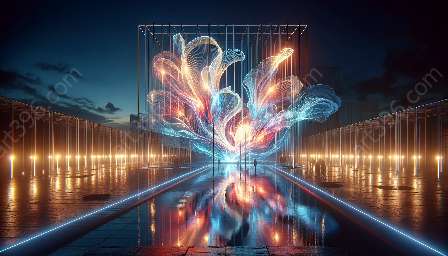For centuries, public spaces and urban landscapes have been the canvas for artistic expressions that reflect the culture and values of a community. In recent years, experimental light art techniques have emerged as a powerful tool for transforming these environments, offering innovative ways to engage with the public and redefine the visual experience of cities. This topic cluster will explore the potential and impact of light art in urban settings, shedding light on the intersection of art and technology, and how it can create immersive and dynamic environments.
Understanding Light Art
Light art is a form of art that utilizes light as a medium to create visual compositions, installations, and performances. It encompasses a wide range of techniques and technologies, from traditional methods such as projection and illumination to cutting-edge innovations like interactive digital displays and LED installations. Experimental light art pushes the boundaries of traditional artistic expression, often blurring the lines between art, design, and technology. By harnessing the power of light, artists can manipulate space, alter perception, and generate emotional responses, offering a unique way to engage and interact with urban environments.
The Transformative Power of Light Art in Public Spaces
Experimental light art techniques have the potential to redefine the way we perceive and experience public spaces and urban landscapes. Through the strategic use of light, artists can enhance architectural features, highlight cultural landmarks, and create immersive environments that captivate and inspire passersby. By integrating light art into urban planning and design, cities can become vibrant, dynamic stages for artistic expression, fostering a sense of community and cultural identity.
Enhancing the Urban Aesthetic
Light art installations have the power to transform the aesthetic of public spaces, turning mundane areas into captivating visual experiences. Whether through temporary installations or permanent fixtures, light art can breathe new life into urban landscapes, offering a fresh perspective on familiar surroundings. From vibrant light sculptures to interactive lighting displays, these interventions can reinvigorate public spaces, creating a unique sense of place and identity within the city.
Engaging the Community
One of the most compelling aspects of experimental light art techniques is their ability to engage and involve the community. Through participatory installations, interactive experiences, and public art events, light art can bring people together, fostering a sense of belonging and shared ownership of public spaces. By creating inclusive and accessible artistic expressions, cities can promote social cohesion and cultural dialogue, enriching the urban fabric with diverse narratives and perspectives.
Light Art as Urban Intervention
Experimental light art techniques can serve as powerful urban interventions, addressing social, environmental, and economic challenges within the urban landscape. By leveraging light as a medium, artists can draw attention to important issues, provoke critical reflection, and inspire positive change. From raising awareness of environmental sustainability to promoting social equity, light art can become a vehicle for delivering meaningful messages and catalyzing urban transformation.
Environmental Sustainability
Light art installations can incorporate sustainable practices and technologies, serving as beacons of environmental consciousness within the city. Through the use of energy-efficient lighting, renewable materials, and innovative design strategies, artists can demonstrate the possibilities of sustainable urban interventions, encouraging cities to embrace ecological responsibility and resilience.
Social Inclusion
Experimental light art techniques can also address issues of social inclusion and equity within the urban context. By creating inclusive and accessible installations, artists can promote diversity, representation, and empathy, fostering a sense of belonging for all members of the community. Through collaborative and community-driven projects, light art can celebrate cultural diversity and amplify marginalized voices, shaping more inclusive and equitable urban environments.
Urban Revitalization
In addition, light art can contribute to the revitalization of urban areas, serving as a catalyst for economic development and cultural enrichment. By transforming neglected spaces into vibrant showcases of artistic expression, cities can attract tourism, investment, and creative industries, breathing new energy into underutilized urban landscapes and fostering a thriving creative economy.
The Future of Urban Light Art
- The convergence of art and technology is propelling light art into new frontiers, offering exciting possibilities for the future of urban expression. From advances in interactive media to the integration of data visualization and urban infrastructure, experimental light art techniques are poised to reshape the urban landscape in unprecedented ways, blurring the boundaries between art, design, and urbanism.
- With the rise of smart cities and digital environments, light art has the potential to become an integral part of urban planning and design, shaping the nighttime identity of cities and enhancing the experiences of citizens and visitors alike. As urban dwellers seek more engaging and immersive environments, light art can play a pivotal role in creating dynamic, responsive, and sustainable urban landscapes that inspire awe and wonder.
- Furthermore, the democratization of technology and the accessibility of creative tools are empowering a new generation of artists to explore the possibilities of light art, fueling a diverse and inclusive urban cultural scene. Through interdisciplinary collaborations and community-driven initiatives, light art has the capacity to redefine the relationship between people, art, and the built environment, fostering a more dynamic and enriching urban experience for all.
Conclusion
Experimental light art techniques have the potential to transform public spaces and urban landscapes into captivating and immersive environments that engage, inspire, and reflect the culture and identity of a community. By harnessing the transformative power of light, artists can redefine the aesthetic, social, and environmental dimensions of urban contexts, offering new ways to experience and interact with the city. As cities embrace the possibilities of light art, they can cultivate unique nighttime identities, foster cultural vibrancy, and enrich the urban experience for residents and visitors alike.

